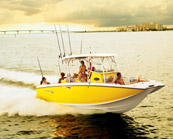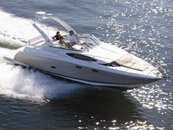If you’ve ever wanted to have superhuman powers, like the ability to see things in the dark, or in the rain, or fog—you might be a good candidate for a radar system on your boat.
History
Although the concept of detecting objects with radio waves was patented at the beginning of the twentieth century, radar as we know it didn’t come of its own until the advent of World War II, when military necessity expedited the development of this technology. Trivia fact: the word “radar” is actually an acronym for Radio Detection and Ranging.
Fundamentals
The two major components of a radar system that are most obvious are the display and the antenna.
The display, usually located at the helm, shows the radar’s activity in either color or monochrome, depending on the unit.
A radar antenna is either enclosed in a low, cylindrical container called a radome, or is mounted up high, free to rotate in the open array configuration.
A radar unit sends out high-frequency radio waves from a revolving antenna. These waves zoom through the atmosphere until they hit something, then the waves bounce back to the antenna. By calculating the time it takes for the waves to go out and return, the radar can determine approximately how far away objects (land, boats, buoys) are, and because the antenna is rotating, the radar can also provide a direction (bearing) to the object.
Multiple Functions
Multifunctional radar systems can incorporate a chartplotter, sonar, and the radar into one, compact device, saving valuable console space and making the task of managing the vessel decidedly easier.
Some radar units can also superimpose the radar display over a nautical chart to take much of the guesswork out of finding your way on unfamiliar waters.
In addition, most high-end radars have the capability of showing radar activity on multiple displays in different locations on the boat.


